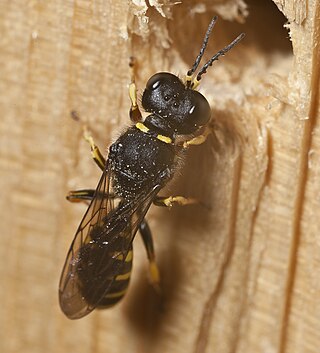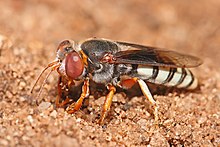
Sceliphron, also known as black mud daubers or black mud-dauber wasps, is a genus of Hymenoptera of the Sphecidae family of wasps. They are solitary mud daubers and build nests made of mud. Nests are frequently constructed in shaded niches, often just inside of windows or vent openings, and it may take a female only a day to construct a cell requiring dozens of trips carrying mud. Females will add new cells one by one to the nest after each cell is provisioned. They provision these nests with spiders, such as crab spiders, orb-weaver spiders and jumping spiders in particular, as food for the developing larvae. Each mud cell contains one egg and is provided with several prey items. Females of some species lay a modest average of 15 eggs over their whole lifespan. Various parasites attack these nests, including several species of cuckoo wasps, primarily by sneaking into the nest while the resident mud dauber is out foraging.

Cicada killer wasps are large, solitary, ground-dwelling, predatory wasps. They are so named because they hunt cicadas and provision their nests with them, after stinging and paralyzing them. Twenty-one species worldwide are recognized. The highest diversity occurs in the region between North Africa and Central Asia.

Tenthredinidae is the largest family of sawflies, with well over 7,500 species worldwide, divided into 430 genera. Larvae are herbivores and typically feed on the foliage of trees and shrubs, with occasional exceptions that are leaf miners, stem borers, or gall makers. The larvae of externally feeding species resemble small caterpillars. As with all hymenopterans, common sawflies undergo complete metamorphosis.

Bembix rostrata is a species of sand wasp native to Central Europe. The genus Bembix - of which B. rostrata is among the most distinctive species - has over 340 species worldwide and is found mostly in warm regions with open, sandy soils; Australia and Africa have a particularly rich variety of species.

Pepsis is a genus of spider wasps belonging to the family Pompilidae. Species within this genus are also called tarantula hawks, as they usually hunt tarantulas, similarly to many species in the genus Hemipepsis. These wasps are restricted to the Americas, with the related genus Hemipepsis occurring in both Old and New Worlds.

Pemphredonidae is a family of aphid wasps formerly treated as the subfamily Pemphredoninae. There are 19 genera and 556 described species in the family.

The Pepsinae are a subfamily of the spider wasp family, Pompilidae, including the two genera of large tarantula hawks, as well as many genera of smaller species.

Chrysis is a very large genus of cuckoo wasps. It is the largest genus in the family, including over 1,000 species in over 20 subgenera, as speciose as all remaining Chrysididae combined. The generic name is derived from Greek chrysis, "gold vessel, gold-embroidered dress", and pays tribute to the brilliant metallic appearance of wasps in the genus.

Prionyx is a genus of wasps in the family Sphecidae. They are known to hunt and feed on grasshoppers.

Holopyga is a genus of cuckoo wasps.

Crossocerus is a genus of square-headed wasps in the family Crabronidae. There are at least 250 described species in Crossocerus.

Crabro is a genus of square-headed wasps belonging to the family Crabronidae. There are at least 80 described species in Crabro, found in the Nearctic and Palaearctic (Holarctic).

Ectemnius is a genus of wasps in the family Crabronidae. 188 species are known. The genus is found around the world but Australia has only two species.

Stizoides is a genus of kleptoparasitic sand wasps in the family Bembicidae. There are at least 30 described species in Stizoides.

Pepsini is a tribe of spider wasps in the family Pompilidae.

Dryudella is a genus of wasps in the family Astatidae. There are more than 50 described species in Dryudella.

Ferreola is a genus of wasps belonging to the family Pompilidae.
This page is based on this
Wikipedia article Text is available under the
CC BY-SA 4.0 license; additional terms may apply.
Images, videos and audio are available under their respective licenses.


















